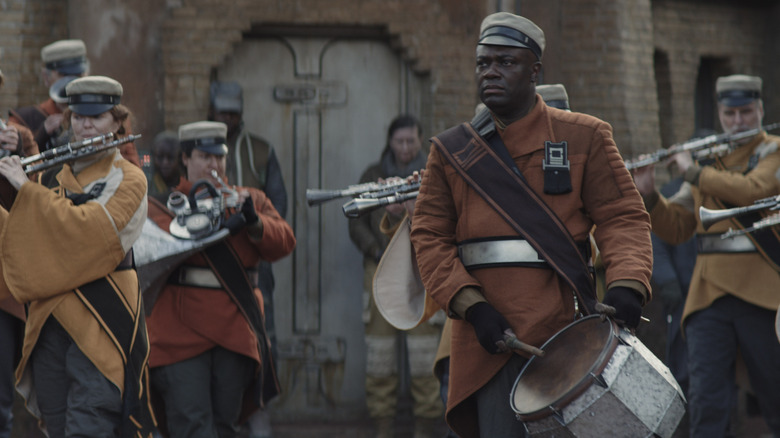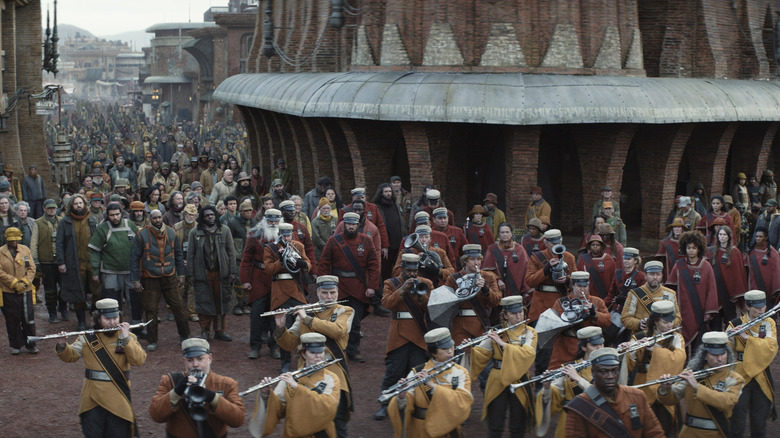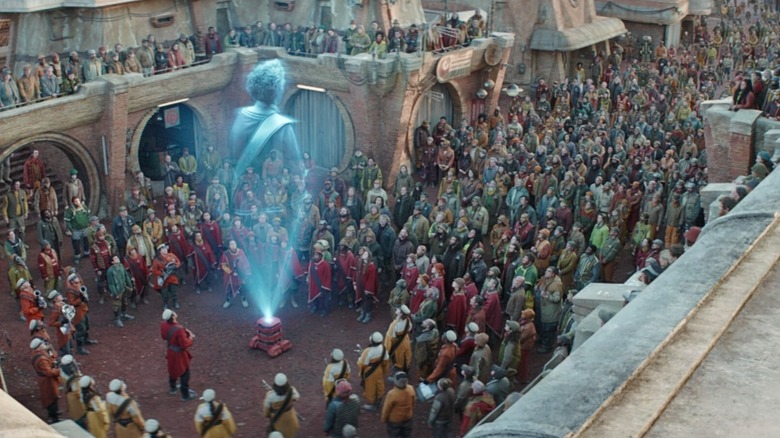The Song Of Ferrix In The Andor Season 1 Finale Was Composed Before Shooting Even Began [Exclusive]
Beware of spoilers for the season finale of "Andor" below.
Over the past two months, "Andor" has reaffirmed time and time again the promise of George Lucas' galaxy far, far away. Whatever you may think of the individual films, shows, games or books that have been released over the years, you can't deny that Lucas created an expansive world full of possibilities where all kinds of stories could be told. Whether it was the original Expanded Universe (now Legends) or the new spin-offs, "Star Wars" has always been bigger than just any one story.
Tony Gilroy, both in his reshoots of "Rogue One" and in the creation of "Andor," has brought "Star Wars" to a more grounded place than the franchise had ever been before — at least in live-action. We've seen the show move from the franchise's fantasy in space to dystopian, political science fiction. Like "Rogue One," the show takes things that were present in the original trilogy but were mostly in the background, like the oppression of the Empire, the desperation of the Rebellion, and the dire state of the galaxy.
We saw the Empire show its true colors, not as some cartoonishly evil entity, but a real authoritarian and fascistic government with complete condescendence for other cultures, and sadistic punishments for its people. We saw a Rebellion that was more than just a sanitized group of chivalrous knights fighting evil with good, and we met a group of desperate, radicalized commoners (and a few high-borns) who were tired of oppression and willing to give their absolute all for freedom.
All of this culminated with a spectacular, moving, thrilling, and rousing finale that brought (almost) every plot line and character together in one place, for a funeral-turned-rebellion that briefly turned "Star Wars" into Victor Hugo's "Les Misérables." Do you hear the people sing? They're singing The Song of Ferrix.
Do you hear the people sing?
After dropping subtle hints that she gave up what could have been a life dedicated to fighting the Empire to taking care of Andor, Maarva (Fiona Shaw) tragically died off-screen after proclaiming that she was so moved and inspired by the job on Aldhani that she'd spend the remaining of her days as a rebel. (She had to know it was Andor, right? She looked like she knew.)
We knew Maarva was important to the community on Ferrix, and we had heard the term "Daughters of Ferrix" before, but the "Andor" finale truly showed how much Maarva meant to the town, both in life and in death. What the Empire expected to be no more than 40 people turns out to be the entirety of the town marching in unison across the streets of Ferrix while a funeral band played a moving tribute to their fallen sister.
It is a scene that can only be described as if Tony Gilroy and director Benjamin Caron had smuggled their entire cast to the Sondheim Theatre in London, kept the turntable and all the 1830s Parisian sets and decoration, replaced "Do You Hear the People Sing?" with a sci-fi funeral song and General Lamarque's funeral with Maarva's. There are hundreds upon hundreds of people following the funeral procession, openly defying (and scaring) the Empire, all before B2EMO projects a hologram recording of Maarva literally inciting an open rebellion against the Empire, calling people to wake up and rise up. It is a phenomenal scene that will go down as one of the all time greatest "Star Wars" moments, and a scene that will have theater kids hooting and hollering. Truly, the only thing missing was a barricade and a giant elephant statue.
There is a life about to start when tomorrow comes
If this scene felt like the climax of "Andor," the culmination of its themes of rebellion, the moment that pays off most of the threads of the season, well, you might be right. It is a pivotal scene, and it would not work if it wasn't for the music.
In an interview our own Ryan Scott conducted with Tony Gilroy ahead of the season one finale of "Andor," the show's creator talked about the funeral song being so important, it was the first piece of music that Gilroy and composer Nicholas Britell worked on. "This was our attempt to be somewhat terrestrial and to have something that hopefully could only exist in Ferrix. It was a real, total collaboration," Gilroy said. "That's the very first thing that we did." The showrunner went on:
"We need some clanging banging that makes sense. We need to make this music for Ferrix that's the street music. Then we have to have this funeral music, and it's about eight minutes of diegetic music, and we need to build it. I want it really played. I want it to be amateur, and I want it to be aspirational. I want it to be a civic experience."
This musical piece is important for several reasons. Not only does the scene as a whole rule, but it is a rare case of diegetic music being used in the "Star Wars" universe outside of a cantina.
"Andor" has given us many things that were previously unthinkable in "Star Wars," including many of the franchise's darkest moments, but it is also giving us some of its brightest. The whole funeral procession is not only an angry, emotional, motivational scene, it features one of the best musical compositions in the franchise.


